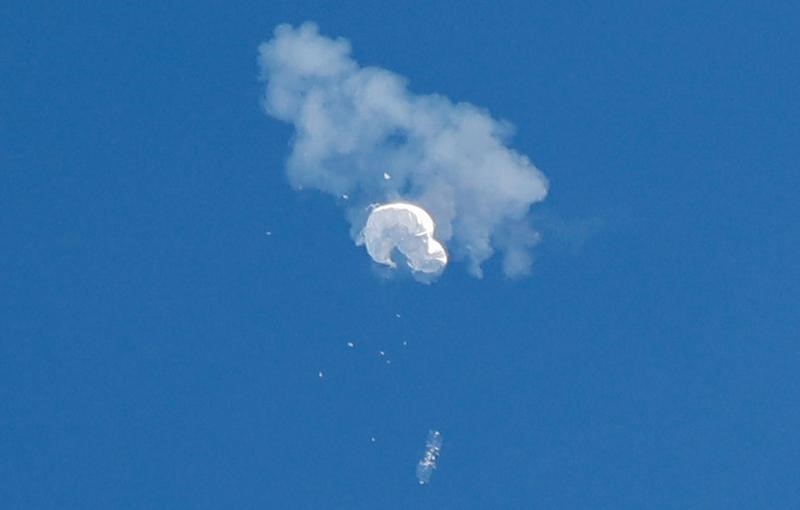SPY BALLOON

Disclaimer: Copyright infringement not intended.
Context: The United States shot down a Chinese surveillance balloon that had floated over American airspace for several days, triggering the latest diplomatic crisis amid already worsening relations between the world’s two biggest powers.
Details:
- Beijing reacted angrily to the shooting down of what the U.S. called a “surveillance balloon” but Chinese authorities maintained that it was a civilian airship used for meteorological purposes that had drifted off course.
- Chinese military said that it now “reserve[s] the right” to take the same measures if a similar situation arose.
- The appearance of the balloon in the skies over the western U.S. State of Montana sparked an unexpected diplomatic row at a time both sides were looking to stabilise increasingly tense relations.
Implications:
- S. Secretary of State Antony Blinken called off a visit to China. Had the visit happened, it would have been the first by a top U.S. diplomat since 2018.
- Beijing has dismissed Washington’s accusations of surveillance and international airspace violation as an attempt to “attack and smear China.”
- Chinese side has verified it and communicated it to the US side that it is a civilian airship used for research, mainly meteorological, purposes. Affected by the Westerlies and with limited self-steering capability, the airship deviated far from its planned course. This is entirely an unexpected situation caused by force majeure and the facts are very clear
Escalating tensions between the US, China:
- The relationship between the US and China have been tense in recent times, with issues ranging from Taiwanand the South China Sea, to human rights in China’s western Xinjiang region and the clampdown on democracy activists in Hong Kong.
- Taiwan specifically has been at the centre of US- China animosity, ever since former House Speaker Nancy Pelosi visited the island nation claimed by China as its own.
- Taiwan scrambled fighter jets, put its navy on alert and activated missile systems in response to nearby operations by 34 Chinese military aircraft and nine warships.
- Blinken’s visit this weekend was meant to thaw relationships and find common ground. Only time will tell whether it will achieve its goals or indeed take place.
The spy balloon:
- Around a decade-and-a-half after the first ever hot air balloon took flight with humans, balloons were already being used for military purposes.
- During the French Revolutionary Wars in the late 18th century, balloons were used to provide a bird’s eye view of the battlefield, with there being documented evidence of their use in the Battle of Fleurus in 1794.
- Since then, balloons have been in use in all kinds of conflict, from the American Civil War to World War I.
- For well over a century, before aircraft technology really took off during the Great War, balloons were the primary mode of big-picture reconnaissance, providing perspective on enemy positions and movements simply impossible to obtain from the ground.
- During World War II, as technologies evolved and balloons could be pushed to higher altitudes, their use evolved as well. For instance, the Japanese military tried to loft incendiary bombs into US territory using balloons designed to float in jet stream air currents.
- After the war, the US military started exploring the use of high-altitude spy balloons, which led to a large-scale series of missions called Project Genet. The project flew photographic balloons over Soviet bloc territory in the 1950s – a time before the sheer ubiquitousness of surveillance satellites we see today.
How relevant are high-altitude balloons today?
- While satellites and improved aeroplane and drone technologies have reduced the salience of high-altitude balloons in the military, they still occupy an important niche.
- Unlike satellites which can cost millions of dollars to create, and require sophisticated technology to launch, high-altitude balloons are cheap and easy to launch and control.
- While balloons cannot directly be steered, they can be roughly guided to a target area by changing altitudes to catch different wind currents
- Moreover, unlike satellites which are at much higher altitudes and moving at incredible speeds, spy balloons have the advantage of being able to hover around at lower heights, thus providing better quality images as well as more time to gather intelligence in a particular area.
MAINS QUESTION:
- Discuss the implications of escalating tensions between China and US on global order. (250 words)
https://epaper.thehindu.com/ccidist-ws/th/th_delhi/issues/23943/OPS/GG6ARF7VE.1+GD5ARFC74.1.html



.jpeg)


1.png)
